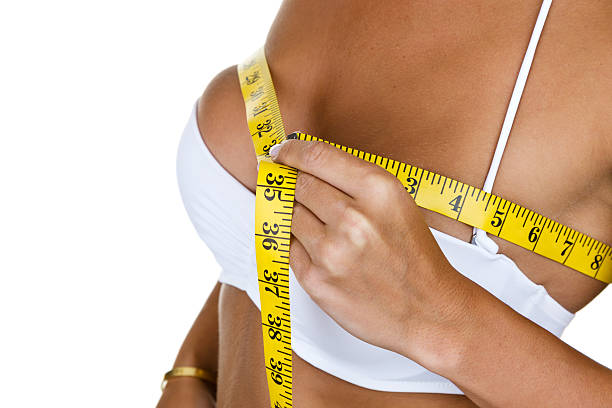
As a woman, one of my consistent struggles is keeping track of my bra size.
It seems that by a certain age that a woman would know her own bra size, but your bra size can change depending on the brand and the various styles that the brand may make (such as strapless, balconette, etc.).
It is even advised to get your bra measurements taken once a year due to how styles, as well as your body, change.
Aging, hormone fluctuations, pregnancy, weight loss or gain, and stress are factors that can result in changes in your breasts.
When considering the various brands of lingerie and bras available, sizes may run differently. For instance, one brand’s DDD-cup may be smaller than the next brand’s DDD-cup.
Unless I decide to have my measurements taken every time I go bra shopping, I’m usually playing a guessing game on my size. How many can relate?
Learning how to efficiently calculate your bra size will be beneficial in the long run for a few reasons.
RELATED: Wearing The Right Size Bra Can Be Life Changing
Bra Size Calculator
The bra size calculator estimates your bra size according to your band (frame) and bust sizes:
- What’s your band/frame size? This is the firm circumference directly underneath the breast (measured at a close fit, not tight!).
- What’s your bust size? This is the loose circumference around the chest at the fullest part of your breasts (wear a properly fitted bra to get a proper measurement while standing straight with your arms to your side).
- What’s your bra cup size? This is the difference between your band and bust size.
How to calculate bra cup size
You will need a measuring tape to measure around your torso directly under your bust, where the bra band would sit. Make sure the tape is level and snug.
For the most accurate measurements, measure to the nearest ¼ inch or ½ cm.

How will you know when you’ve found the perfect bra size?
There are a few signs that indicate that you may not have found the right, let alone perfect, size bra.
- Your breasts should not spill over the sides or middle of the bra.
- “Double breasts” should not form between the cups.
- The cups of your bra should not be loose; they should enclose the whole breast.
- The band around your body should not be pulled up at the back and should form a straight line at the bottom.
- The shoulder straps of your bra should not dig into your skin, and you should be able to comfortably place your finger between your shoulder and the strap.
RELATED: Most Women Wear The Wrong Size Bra – Are You One?
Why You Should Have a Professional Bra Fitting
If all else fails with your ability to determine your true bra size, having a professional bra fitting is best.
Whether you’ve had a professional fitting many times or later in your life, you will be amazed by the results of being fitted with the perfect bra.
The professional fitters can assist you with any problems you have had with choosing the right size bra on your own, as well as introduce you to the best bras that work best for your shape and figure.
Go to your local lingerie boutique or specialty store to get your bra fitting so you can start bra shopping the proper way.
In the end, not only do you save yourself from an improper-looking outfit, but also from any back and breast pains that may come with consistently wearing an ill-fitted bra; this especially holds true for women with larger breasts.

Frequently Asked Questions
1. What is a bra size calculator?
A bra size calculator takes your underbust (band) and overbust (full bust) measurements—usually in inches—and determines your band size and cup size using formulas or sizing charts.
2. How does a bra cup size calculator work?
Once you have your band size:
-
Measure around the fullest part of your bust.
-
Subtract band size from bust measurement—the difference in inches gives your cup size:
-
1″ → A, 2″ → B, 3″ → C,
-
3. How do I calculate bra size at home?
Step 1: Underbust (Band):
-
Wrap a soft tape around just under your breasts, keeping it level.
-
Round to the nearest even number → this is your band size.
Step 2: Overbust:
-
Measure around the fullest part of the bust with the tape measure.
Step 3: Cup Calculation:
-
Subtract band from bust. Use the difference-to-cup chart: 0″→AA, 1→A, 2→B, 3→C, etc.
4. Why are there formulas like “+4 inches” for band size?
Some U.S. methods add 4 inches to the underbust to simplify sizing (e.g., a 30″ underbust becomes band size 34). It’s used less now—many experts prefer rounding to the nearest even number without adding inches.

5. What does “bra size calculator in inches” mean?
It means all measurements are taken in inches (not centimetres). Just measure in inches—no conversion needed!
6. What’s the difference between a bra size calculator USA?
In the U.S., bras use inch-based sizes and lettered cups (A, B, C, D, DD, etc.) Other countries may use centimeters or add different letters.
7. How is a bra size calculator designed?
Most calculators:
-
Accept underbust + overbust measurements.
-
Apply rounding and formulas.
-
Use a lookup table to convert the difference into cup letters.
-
Provide final size (e.g., 34C)
8. Any tips on using a bra size calculator in inches?
-
Measure with a non-padded or lightly padded bra.
-
Keep tape snug but not tight.
-
Round to even numbers for band, nearest whole number for bust
9. What is the best bra size calculator?
Top tools come from:
-
Calculator.net – US, UK, EU sizes included
-
B.Tempt’d and SKIMS – interactive, guidance-based
Tools combining measurement guidance and country-specific sizing charts are most reliable.
10. How do I use a bra cup size calculator US?
Input:
-
Band size: even inch number (e.g., 34)
-
Bust size: full bust measurement (e.g., 37)
Calculator returns: Cup = C, so size = 34C
11. How to calculate bra cup size manually?
Cup size = Overbust (“bust”) − Band. Then match the inch difference:









